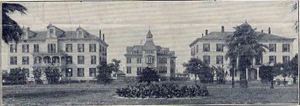Former names Straight College Active 1868–1934 Ceased operations 1934 | Founded 1868 | |
 | ||
Headquarters New Orleans, Louisiana, United States Notable alumni Alice Dunbar Nelson, P B S Pinchback, Walter L Cohen, Theodore K Lawless, James W Ames Similar Dillard University, New Orleans University, Daniel Payne College, Kittrell College, Western University (Kansas) | ||
Straight University, after 1915 Straight College, was a historically black college that operated between 1868 and 1934 in New Orleans, Louisiana. It was founded by the American Missionary Association.
Contents
Campus
The campus faced Canal Street, occupying the block between Tonti and Rocheblave Streets backed by Gasquet (now Cleveland Avenue). After the university was absorbed into the newly created Dillard University, the campus buildings served as a school and YWCA until demolished in 1950.Laborde & Magill, 2006
History
Responding to the post-Civil War need to educate newly freed African Americans in New Orleans, Louisiana and the surrounding region, the American Missionary Association of the Congregational Church founded Straight University on June 12, 1868.
Straight University received its name as recognition for Seymour Straight's initial endowment gift. Straight was a wealthy cheese manufacturer from Hudson, Ohio. In 1915, the name "Straight University" was changed to Straight College which represented the scope of the school's work more accurately. Missionary work was a core concern, which extended from New Orleans to Africa.
Throughout its history, Straight offered courses of study ranging from elementary- to college-level courses in music, and theology.
In 1934, after experiencing financial difficulties, Straight College was merged with New Orleans University to form Dillard University.
Law department
Straight University also offered professional training, including a law department from 1874 to 1886, and its graduates participated in local and national Reconstruction and post-Reconstruction era civil rights struggles. For example, 1876 Straight University Law School graduate Louis André Martinet published The Crusader—a civil rights daily, co-founded the Comité des Citoyens (Citizens' Committee), and played a significant role in the Plessy v. Ferguson landmark Supreme Court case.
The Law department is historically notable because blacks and whites were trained side by side. "It is an interesting fact of our 50 law graduates, 35 have been white." The school struggled to provide its law students a proper research library. The students typically met for classes in the law professors offices.
In 1886, Straight discontinued the Law Department and began to focus on the liberal arts, industrial arts, and teacher training.
Notable alumni
Graduates had an important role in bringing education and medical care to African-Americans during the early part of the 20th Century. Physician James W. Ames, for example, founded the first hospital for blacks in Detroit in 1910. Dunbar Hospital was created for physicians and patients of color, unable to practise or be admitted to Detroit hospitals operated by whites.
Straight's graduates participated in local and national Reconstruction and post-Reconstruction era civil rights struggles. For example, 1876 Straight University Law School graduate, Louis André Martinet, published The Crusader—a civil rights daily, co-founded the Comité des Citoyens (Citizens' Committee), and played a significant role in the Plessy v. Ferguson landmark Supreme Court case. Nellie A. Ramsey Leslie became a pioneer teacher in Indian Territory and later Texas. His classmate Dan Desdunes joined him in this effort before moving to North Omaha, Nebraska to become a notable band leader.
Among other notable alumni are P.B.S. Pinchback (first African American governor of a U.S. state), Mary Booze (first African-American to sit on the Republican National Committee, as the committeewoman from Mississippi from 1924 to 1948), Alice Dunbar Nelson, foremother of the Harlem Renaissance, and Theodore K. Lawless (dermatologist and philanthropist).
